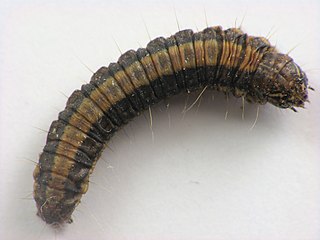Related Research Articles

Salma Hayek Pinault is a Mexican and American actress and film producer. She began her career in Mexico with starring roles in the telenovela Teresa (1989–1991) as well as the romantic drama Midaq Alley (1995). She soon established herself in Hollywood with appearances in films such as Desperado (1995), From Dusk till Dawn (1996), Wild Wild West (1999), and Dogma (1999).

Crambidae comprises the grass moth family of lepidopterans. They are variable in appearance, with the nominal subfamily Crambinae taking up closely folded postures on grass stems where they are inconspicuous, while other subfamilies include brightly coloured and patterned insects that rest in wing-spread attitudes.

The Pyralidae, commonly called pyralid moths, snout moths or grass moths, are a family of Lepidoptera in the ditrysian superfamily Pyraloidea. In many classifications, the grass moths (Crambidae) are included in the Pyralidae as a subfamily, making the combined group one of the largest families in the Lepidoptera. The latest review by Eugene G. Munroe and Maria Alma Solis retain the Crambidae as a full family of Pyraloidea.

Lalla Salma is the former wife of Mohammed VI of Morocco. They married in 2002, and she became the first wife of a Moroccan ruler to have been publicly acknowledged and given a royal title. She was last seen in an official capacity in December 2017, and it was later on reported, in 2018, that she and Mohammed VI had divorced.

The Pyraloidea are a moth superfamily containing about 16,000 described species worldwide, and probably at least as many more remain to be described. They are generally fairly small moths, and as such, they have been traditionally associated with the paraphyletic Microlepidoptera.

Sparassodonta is an extinct order of carnivorous metatherian mammals native to South America, related to modern marsupials. They were once considered to be true marsupials, but are now thought to be a separate side branch that split before the last common ancestor of all modern marsupials. A number of these mammalian predators closely resemble placental predators that evolved separately on other continents, and are cited frequently as examples of convergent evolution. They were first described by Florentino Ameghino, from fossils found in the Santa Cruz beds of Patagonia. Sparassodonts were present throughout South America's long period of "splendid isolation" during the Cenozoic; during this time, they shared the niches for large warm-blooded predators with the flightless terror birds. Previously, it was thought that these mammals died out in the face of competition from "more competitive" placental carnivorans during the Pliocene Great American Interchange, but more recent research has showed that sparassodonts died out long before eutherian carnivores arrived in South America. Sparassodonts have been referred to as borhyaenoids by some authors, but currently the term Borhyaenoidea refers to a restricted subgroup of sparassodonts comprising borhyaenids and their close relatives.

Salmas is a city in the Central District of Salmas County, West Azerbaijan province, Iran, and serves as capital of the county. It is located northwest of Lake Urmia, near Turkey.

Salmas County is in West Azerbaijan province, Iran. It capital is the city of Salmas.

Salma pyrastis is a species of moth of the family Pyralidae. It is found in the south eastern quarter of Australia.
Caffrocrambus is a genus of moths of the family Crambidae.

Palpita is a genus of moths of the family Crambidae. Members of the moth genus Stemorrhages may be very similar in appearance.
Abareia is a monotypic moth genus belonging to the family Pyralidae. It was described by Paul E. S. Whalley in 1970. It contains only one species, Abareia amaurodes, described by Alfred Jefferis Turner in 1947, which is found in Australia.

Aphomia terrenella, the terrenella bee moth, is a moth of the family Pyralidae. It is found in North America from Michigan, Ontario, Quebec and New York south to Georgia.

The Phycitinae are a subfamily of snout moths. Even though the Pyralidae subfamilies are all quite diverse, Phycitinae stand out even by standards of their family: with over 600 genera considered valid and more than 4000 species placed here at present, they unite up more than three-quarters of living snout moth diversity. Together with the closely related Epipaschiinae, they are apparently the most advanced lineage of snout moths.

The Galleriinae are a subfamily of snout moths and occur essentially worldwide, in some cases aided by involuntary introduction by humans. This subfamily includes the wax moths, whose caterpillars (waxworms) are bred on a commercial scale as food for pets and as fishing bait; in the wild, these and other species of Galleriinae may also be harmful to humans as pests.

The Epipaschiinae are a subfamily of snout moths. More than 720 species are known today, which are found mainly in the tropics and subtropics. Some occur in temperate regions, but the subfamily is apparently completely absent from Europe, at least as native species. A few Epipaschiinae are crop pests that may occasionally become economically significant.
Thiallela epicrociella is a species of moth of the family Pyralidae described by Embrik Strand in 1919. It is found in Taiwan.
Aphomia taiwanalis is a species of moth of the family Pyralidae described by Jinshichi Shibuya in 1928. It is found in Taiwan.
Epilepia melapastalis is a species of snout moth in the genus Epilepia. It was described by George Hampson in 1906, and it is known from Réunion, Mozambique, South Africa and Zimbabwe.

Salma is a genus of snout moths. It was described by Francis Walker in 1863.
References
- ↑ "GlobIZ search". Global Information System on Pyraloidea. Retrieved June 8, 2017.
- ↑ The Systematic Study on the Formosan Pyralidae